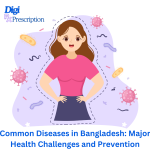
Bangladesh faces a significant burden of diseases due to rapid urbanization, climate change, poor sanitation, and a lack of access to quality healthcare. Both communicable and non-communicable diseases are prevalent, affecting millions of people every year. In this blog post, we will explore the most common diseases in Bangladesh, their causes, symptoms, and prevention strategies.
1. Dengue Fever
Dengue fever is one of the most serious vector-borne diseases in Bangladesh, especially during the monsoon season.
Cause: Spread by Aedes mosquitoes.
Symptoms: High fever, severe body pain, rashes, and bleeding tendencies.
2023 Outbreak: Over 321,000 cases and 1,705 deaths reported.
2024 Situation: More than 78,000 hospitalizations and 400+ deaths recorded.
Prevention: Use mosquito repellents, keep surroundings clean, and remove stagnant water.
???? Source: Reuters
2. Tuberculosis (TB)
Bangladesh is among the top 10 high-burden TB countries in the world.
Cause: Mycobacterium tuberculosis infection.
Symptoms: Persistent cough, weight loss, fever, and night sweats.
Annual Cases: More than 220,000 new infections.
Mortality Rate: 24 per 100,000 people.
Prevention: BCG vaccination, early detection, and complete antibiotic treatment.
???? Source: Global TB Report, WHO
3. Air Pollution-Related Diseases
Bangladesh has one of the worst air pollution levels in the world, contributing to severe respiratory and cardiovascular diseases.
Annual Death Toll: Over 235,000 deaths linked to air pollution.
Common Diseases: COPD, asthma, lung cancer, and stroke.
Impact on Children: More than 19,000 child deaths annually.
Prevention: Reduce emissions, wear masks, and improve indoor air quality.
???? Source: UNICEF Bangladesh
4. Cardiovascular Diseases (CVDs)
Heart disease is the leading cause of death in Bangladesh.
Common Conditions: Stroke, ischemic heart disease, and hypertension.
Mortality Rate: Stroke (72.3 per 100,000), heart disease (67.6 per 100,000).
Risk Factors: Smoking, high cholesterol, diabetes, and obesity.
Prevention: Healthy diet, regular exercise, and stress management.
???? Source: WHO Health Data
5. Diabetes
Diabetes is increasing at an alarming rate in Bangladesh due to lifestyle changes.
Prevalence: Over 13 million people affected.
Risk Factors: Poor diet, lack of exercise, obesity, and genetics.
Complications: Blindness, kidney failure, and heart disease.
Prevention: Eat a balanced diet, avoid sugary foods, and monitor blood sugar levels.
???? Source: [Diabetes Association of Bangladesh]
6. Waterborne Diseases (Diarrhea, Cholera, Typhoid)
Poor sanitation and unsafe drinking water cause frequent outbreaks of waterborne diseases.
Diarrheal Diseases: Responsible for 100,000+ hospitalizations annually.
Cholera Outbreaks: Common during floods and natural disasters.
Symptoms: Severe dehydration, vomiting, and stomach pain.
Prevention: Drink boiled or filtered water, wash hands, and get vaccinated.
???? Source: ICDDR,B
7. Chronic Kidney Disease (CKD)
Kidney diseases are rising due to high blood pressure, diabetes, and pollution.
Prevalence: About 20 million people affected.
Major Causes: Diabetes, hypertension, and high salt intake.
Treatment Challenges: Limited dialysis centers and high treatment costs.
Prevention: Control blood pressure, drink enough water, and reduce salt intake.
???? Source: [Bangladesh Renal Association]
8. Malnutrition & Stunting in Children
Malnutrition remains a serious issue, affecting millions of children.
Stunting Rate: 28% of children under five are stunted.
Wasting Rate: 10% of children suffer from acute malnutrition.
Causes: Poor maternal nutrition, food insecurity, and lack of breastfeeding.
Prevention: Provide nutritious food, promote exclusive breastfeeding, and educate parents.
???? Source: UNICEF Bangladesh
9. Hepatitis B & C
Viral hepatitis is a silent epidemic in Bangladesh.
Hepatitis B Prevalence: 3-5% of the population.
Hepatitis C Cases: Increasing due to unsafe medical practices.
Symptoms: Jaundice, liver failure, and fatigue.
Prevention: Vaccination, safe medical procedures, and regular screenings.
???? Source: [Bangladesh Liver Foundation]
10. Mental Health Disorders
Mental health issues are on the rise, but access to care is limited.
Depression Prevalence: Over 4.6 million Bangladeshis suffer from depression.
Causes: Poverty, stress, lack of awareness, and social stigma.
Challenges: Lack of mental health professionals and treatment facilities.
Prevention: Increase awareness, provide counseling services, and reduce stigma.
???? Source: [National Institute of Mental Health (NIMH), Bangladesh]
Conclusion
Bangladesh faces a dual burden of infectious and non-communicable diseases, made worse by environmental challenges and a lack of healthcare resources. Preventive measures, early diagnosis, and government interventions are crucial to improving the country’s public health. With increased awareness and better healthcare policies, Bangladesh can reduce the impact of these common diseases and improve overall well-being.
References:
WHO Health Data – WHO
UNICEF Bangladesh – UNICEF
Reuters Dengue Report – Reuters
Bangladesh Liver Foundation
Diabetes Association of Bangladesh
ICDDR,B – ICDDR,B
National Institute of Mental Health (NIMH), Bangladesh
